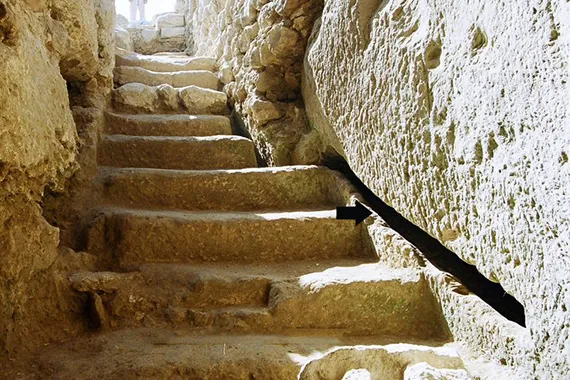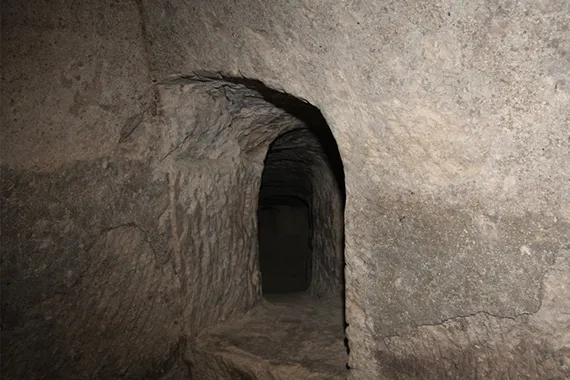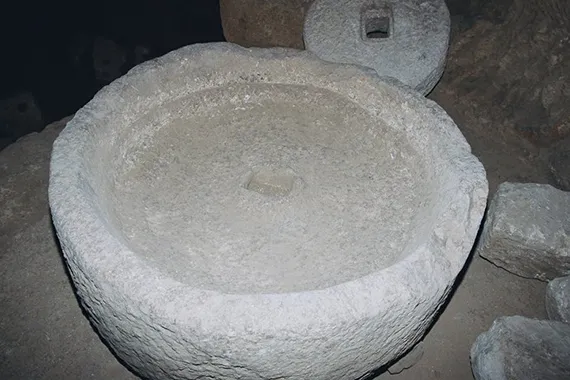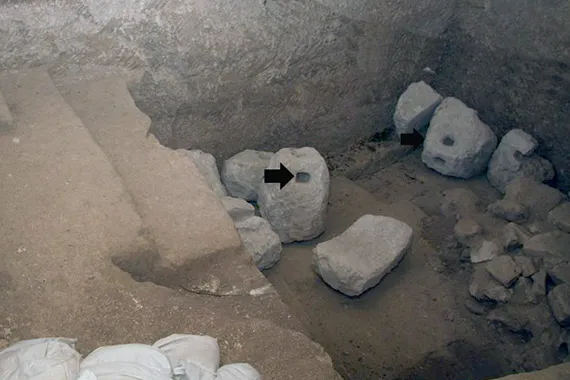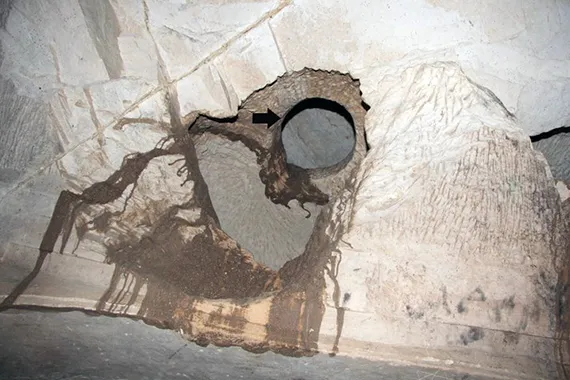
Olive Press
In early October 2005 Dr. Gutfeld’s archaeology team arrived at the site, slightly unsure of what awaited them although they were familiar with the basilica church and the Jerusalem Cave. The surrounding region was riddled with large boulders and the remains of crude medieval structures. The team surveyed the site, exploring what was visible on the surface to decide where best to establish excavation areas. They decided on two: the first comprised a concentration of what seemed to be the foundations of medieval dwellings and could thus make up part of a village that existed during that time; and the second was where they had come across evidence of crude and hurried “excavations” carried out by antiquities looters. The former would become the village area, and the latter the subterranean oil press and ritual bath complex.
The first day’s work in the latter area exposed a number of square and rectangular-shaped openings carefully carved into bedrock. The team entered one of these openings, which was in fact a seven-foot deep shaft, leading them into a well-hewn tunnel that wound its way for a short distance before reaching its final destination. At the time, they were convinced that the tunnel system was one of countless others that dotted the landscape of the Judean Lowland. These were apparently hewn into the soft limestone by Jewish rebels and refugees during one of the two massive and disastrous revolts against Rome (the Great Revolt of 66-70 AD and the Bar Kokhba Revolt of 132-135 AD). Today they are not as sure that all the tunnels were carved during the revolts and believe that at least some may be connected to the numerous industrial installations discovered at the site.
The tunnel deposited the archaeologists into a large earth and debris-filled chamber, reached by a short drop onto the huge pile of earth that had accumulated over the millennia. Once their eyes had adjusted to the darkness, they realized that they had stumbled upon an oil, or olive, press. Moreover, this was no modest Byzantine oil press like the one seen adjacent to the basilica church, but rather a finely crafted and sophisticated press typical of the Late Hellenistic period (2nd century BC). Indeed, in its first phase, it was likely built by the Hellenized Idumean inhabitants of the village. The team could also make out a large entrance that was blocked by the earth and rocks from the inside and completely hidden from the outside.
Making their way back outside via the tunnel, they then estimated where to send a tractor to remove earth and hopefully expose some sign of the oil press entrance from the outside, at which point the team could continue excavating manually. Their calculations proved correct, and they discovered a stepped passageway that descended to the oil press.
Yet another surprise awaited the team: a chamber was discovered immediately to the left (west) of the oil press, its entrance partly blocked by debris. This would turn out to be the Jewish ritual bath (miqveh), though they did not know it at the time, and would not begin excavating it until Spring 2006. Since then, with the help of dozens of energetic volunteers, the oil press and ritual bath have been excavated in their entirety.
The oil press, entirely rock-hewn, comprises of a large basin in which olives were stored, a large stone crushing basin and crushing stone for the initial crushing of the olives, and three pressing installations for squeezing the oil. “Frails” (baskets) holding the olives were suspended from a wooden beam that fitted them into a niche in the wall above the pressing installations, and force was exerted on them with the help of stone weights (seen on the floor of the oil press). The suspended frails were inserted into basins. To prepare them for the pressing process, olives were placed on the crushing basin and crushed by the aptly named crushing stone. The crushing stone was turned either by a donkey or one or two workers.
As mentioned, the oil press was constructed between the late second century and the first century BC, and apparently remained in use until the Bar Kokhba Revolt of the second century AD. An almost perfectly preserved Herodian oil lamp supports the dating of the oil press. The three crudely inscribed menorahs discovered on the oil press walls may have been the work of Jews who settled at the site following the Hasmonean defeat of the Idumeans around 112 BC.
At some point after it was abandoned, the oil press was converted into a quarry, and its floor was then systematically lowered by some ten feet. During excavation, dozens of tons of earth were moved solely by volunteers. Buckets were filled with earth and rocks hauled up the stepped passageway with the help of the “bucket brigade.”
Video
Video Transcript
We are on top of the subterranean complex of the olive press and the ritual bath uncovered by us in 2005. The excavation of the site actually started here in October 2005, after I noticed antique looters were digging here illegally. After a few days of excavation we found a shaft hewn in the rock that lead to a subterranean tunnel. When we crawled inside the tunnel we came to the ceiling, to the top of the subterranean complex, first to the olive press and later to the ritual bath.
The olive press was established in the 2nd century B.C.E. by the Idumeans, who were a pagan people who lived in this area from the 4th and the 3rd century B.C.E. until the Hasmonean, the Maccabees, conquest in 112 B.C.E. Then the site became a Jewish site, and then they added the ritual bath attached to the olive press. Inside the olive press we uncovered three large presses and a huge crater that could hold one thousand pound of olives as well as an intact grinding stone next to it.
Next to the olive press we uncovered a Jewish ritual bath, where the people who worked in the olive press immersed themselves every day in order to be pure before they started work. It is very important in Judaism to be pure while you’re manufacturing olive oil. (Perhaps they will use this olive oil in the Temple in Jerusalem and in order to do that you have to be pure.) We uncovered a complete ritual bath, which includes a water channel, steps, a window where the water gets inside, and seven benches plastered with hydraulic plaster, and in the lower part of the ritual bath, the pool, where we found a few pure pottery cups that the people used when the level of the water was low. We find the link between the ritual bath and the olive press in order that the olive oil will be pure and kosher before it was sent to the Temple in Jerusalem.
Virtual Tour
The virtual tour for this location works on your computer web browser as well as a tablet or a phone. Best of all, it works on your headset. For instructions using an Oculus Quest, please see our virtual visit page.
Image Gallery

